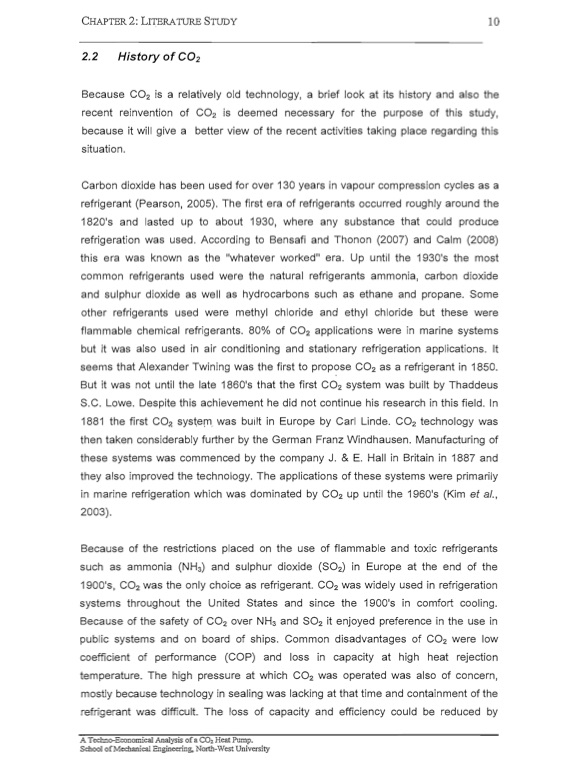
PDF Publication Title:
Text from PDF Page: 022
CHAPTER 2: LITERATURE STUDY 10 2.2 History of CO2 Because CO2 is a relatively old technology, a brief look at its history and also the recent reinvention of CO2 is deemed necessary for the purpose of this study, because it will give a better view of the recent activities taking place regarding this situation. Carbon dioxide has been used for over 130 years in vapour compression cycles as a refrigerant (Pearson, 2005). The first era of refrigerants occurred roughly around the 1820's and lasted up to about 1930, where any substance that could produce refrigeration was used. According to Bensafi and Thonon (2007) and Calm (2008) this era was known as the "whatever worked" era. Up until the 1930's the most common refrigerants used were the natural refrigerants ammonia, carbon dioxide and sulphur dioxide as well as hydrocarbons such as ethane and propane. Some other refrigerants used were methyl chloride and ethyl chloride but these were flammable chemical refrigerants. 80% of CO2 applications were in marine systems but it was also used in air conditioning and stationary refrigeration applications. It seems that Alexander Twining was the first to propose CO2 as a refrigerant in 1850. But it was not until the late 1860's that the first CO2 system was built by Thaddeus S.C. Lowe. Despite this achievement he did not continue his research in this field. In 1881 the first CO2 system was built in Europe by Carl Linde. CO2 technology was then taken considerably further by the German Windhausen. Manufacturing of these systems was commenced by the company J. & E. Hall in Britain in 1887 and they also improved the technology. The applications of these systems were primarily in marine refrigeration which was dominated by CO2 up until the 1960's (Kim et a/., 2003). Because of the restrictions placed on the use of flammable and toxic refrigerants such as ammonia (NH3) and sulphur dioxide (S02) in Europe at the end of the 1900's, CO2was the only choice as refrigerant. CO2 was widely used in refrigeration systems throughout the United States and since the 1900's in comfort cooling. Because of the safety of CO2 over NH3 and S02 it enjoyed preference in the use in public systems and on board of ships. Common disadvantages of were low coefficient of performance (COP) and loss in capacity at high heat rejection temperature. The high pressure at which CO2 was operated was also of concern, mostly because technology in sealing was lacking at that time and containment of the refrigerant was difficult. The loss of capacity and efficiency could be reduced by A Teclmo-Economical Analysis of a CO2 Heat Pump. School of Mechanical Engineering, North-West UniversityPDF Image | CO2 HEAT PUMP Analysis

PDF Search Title:
CO2 HEAT PUMP AnalysisOriginal File Name Searched:
co2-heat-pump-techno-analysis.pdfDIY PDF Search: Google It | Yahoo | Bing
CO2 Organic Rankine Cycle Experimenter Platform The supercritical CO2 phase change system is both a heat pump and organic rankine cycle which can be used for those purposes and as a supercritical extractor for advanced subcritical and supercritical extraction technology. Uses include producing nanoparticles, precious metal CO2 extraction, lithium battery recycling, and other applications... More Info
Heat Pumps CO2 ORC Heat Pump System Platform More Info
| CONTACT TEL: 608-238-6001 Email: greg@infinityturbine.com | RSS | AMP |